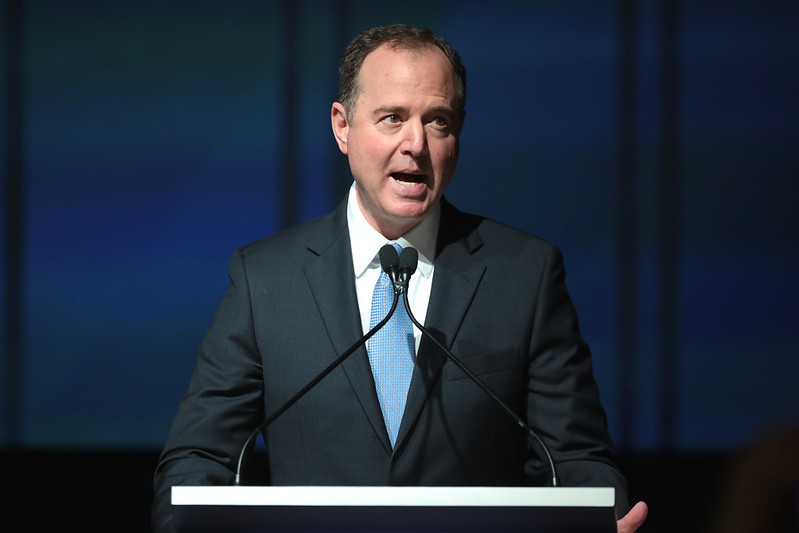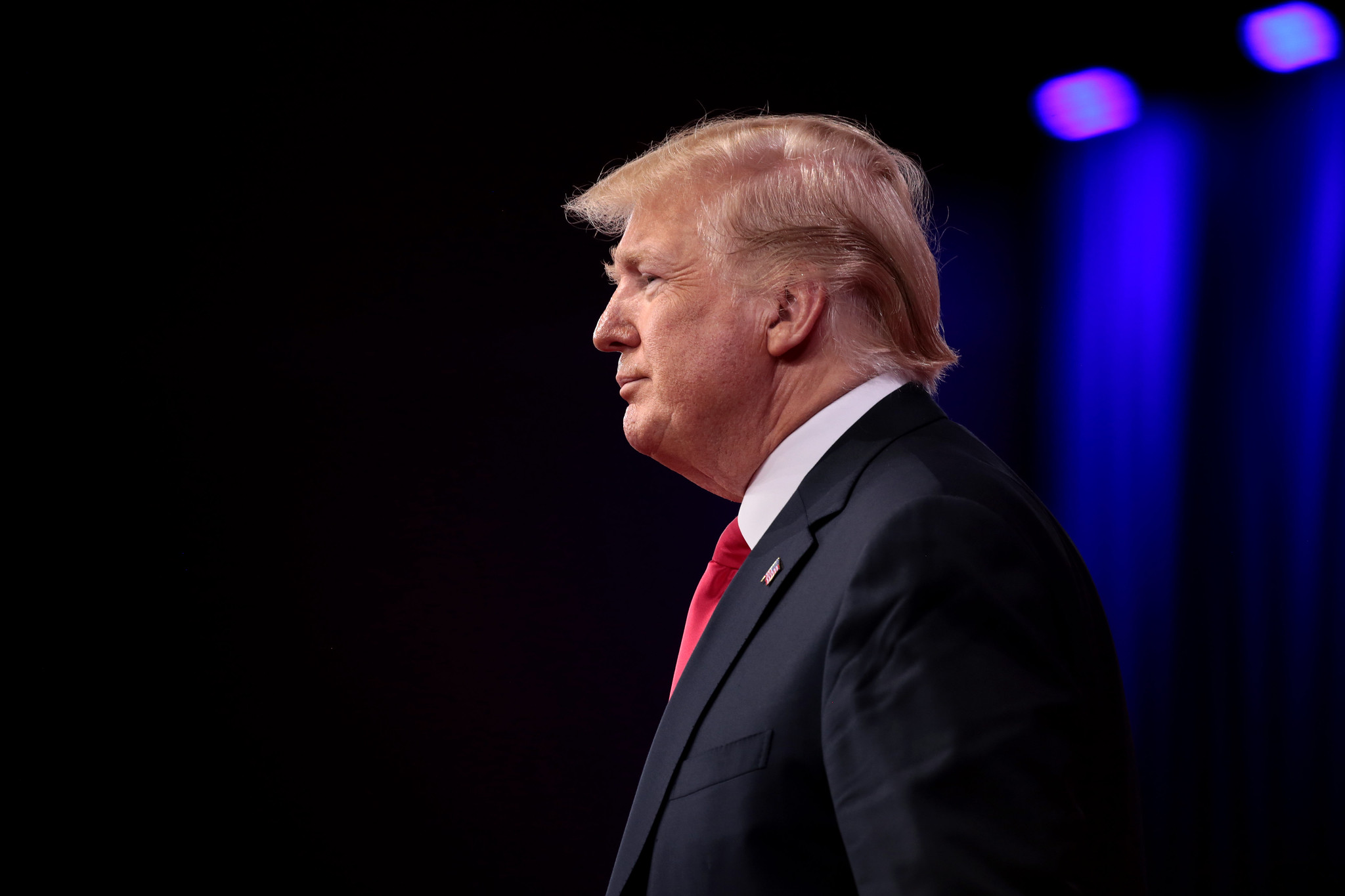How the Schiff Report Deals With Disinformation
The House Intelligence Committee report on impeachment engages minimally with the conspiracy theories propagated by the president’s defenders.

Published by The Lawfare Institute
in Cooperation With

Over the past several years, journalists and researchers have struggled with the question of how to respond to disinformation without amplifying the very falsehoods they’re seeking to disprove. In his committee’s report on the impeachment investigation into President Trump, House Intelligence Committee Chairman Adam Schiff appears to have adopted one common strategy for dealing with disinformation: Deny it the attention it needs to grow.
The report released by the House Intelligence Committee on Dec. 5 is a thorough document: 300 pages long with more than a thousand footnotes. It spells out in exacting, sometimes excruciating detail the story of the president’s efforts to extort the Ukrainian government for personal benefit, along with the Trump administration’s subsequent campaign to obstruct the congressional investigation into his behavior toward Ukraine. But there are some things the report doesn’t address. It’s silent on the subject of the “black ledger,” the document showing under-the-table payments from former Ukrainian President Viktor Yanukovych to Trump campaign chairman Paul Manafort. It says nothing about the political consultant Alexandra Chalupa. And there are exactly zero mentions of the Steele dossier.
On the face of it, none of these omissions is particularly surprising; after all, none of those issues has much to do with evaluating Trump’s conduct. But the report’s silence on these matters is notable, because during the impeachment hearings, Republicans on the Intelligence Committee focused considerable attention on conspiracy theories concerning the black ledger, Chalupa, and Steele—among other things—in an effort to defend the president. Despite the prevalence of these theories in Republican talking points, the House Intelligence Committee report doesn’t spend much time rebutting them. Instead, the committee seems to have made a different call, minimally engaging the seamy, conspiratorial world of the president’s defense.
Writing in BuzzFeed News, reporter Ryan Broderick argued that that House Intelligence Committee hearings were really two hearings at once—one Democratic hearing focused on establishing the facts of the Ukraine scandal, and one Republican hearing “seek[ing] to create not just a counternarrative but a completely separate reality,” designed to produce “bite-size Facebook posts” and clips for Fox News. Broderick explains how that “separate reality” depended on asking the witnesses questions designed to give airtime to discredited theories prominent in the far-right press, like the idea that the black ledger was falsified and released in order to discredit Manafort and thus the Trump campaign. The most prominent of these theories—and perhaps the most absurd—involves the notion, referenced by Trump in his call with Ukrainian President Volodymyr Zelensky, that the Democratic National Committee server hacked by the Russian government in 2016 is a physical server that was removed to Ukraine in an effort to hide from the FBI the fact that Russia did not actually attack the DNC, because CrowdStrike—the cybersecurity company that initially investigated the hacking—is owned by a Ukrainian. None of these assertions is true.
The Republican staff report criticizing the impeachment inquiry steers clear of the more extreme theories. But the hearings themselves seeded these ideas into the mainstream of the Republican impeachment discussion. In writing their report, therefore, committee Democrats faced the question of whether to address these theories in order to debunk them or whether to focus instead on telling their own story—shoring up the strength of their own “separate reality,” to use Broderick’s language.
It might seem strange that the Democratic members of the Intelligence Committee wouldn’t take the opportunity to definitively rebut all these conspiracy theories. But doing so is a complicated proposition. One of us has written about the “cycle of distraction” created by House Intelligence Committee Ranking Member (then Chairman) Devin Nunes’s efforts to raise questions over alleged abuses of the Foreign Intelligence Surveillance Act (FISA) process in the context of the Russia investigation. What was true then is true now: Nunes and his colleagues’ arguments are more about generating distrust and confusion than they are about exonerating the president or proving wrongdoing by his enemies. Focusing on debunking a specific claim risks playing into this dynamic by giving the falsehood additional attention that prolongs its lifespan in the news cycle.
What’s more, a debunking can also add to the confusion it seeks to clear: In order to explain why the CrowdStrike conspiracy theory is false, one needs to explain CrowdStrike, the Russian (not Ukrainian) national origin of the company’s co-founder, Dmitri Alperovitch. One also needs to explain the nature of a physical versus a cloud-based server. And by the end of this process, the conversation has moved far from the core story about the president’s abuses of power in Ukraine. For House Democrats, there’s a risk that the long-winded explanation necessary to debunk the nonsense could lead members of the public to tune out impeachment because it’s “too complicated.”
There are other risks, too. Research suggests that the more a claim is repeated, the more likely people are to believe it, even in the context of a debunking. So stating that “the DNC server is not in Ukraine” could lead readers to have more, rather than fewer, doubts over whether the server actually is in Ukraine, much less whether there is a physical server at all. (This has proved difficult to navigate for media outlets struggling to report on the president’s falsehoods.) There’s also what social scientist danah boyd (boyd styles her name in lowercase) has termed the “boomerang effect,” in which a media outlet’s effort to debunk a false story prompts those who don’t trust the media to believe that the story must be true. In a 2018 report, Whitney Phillips, a researcher at Syracuse University, described concerns among journalists that reporting on disinformation and far-right extremism risks giving “oxygen” to harmful theories and ideas. Amplification of these ideas—even in debunking or criticizing them—risks “lending credence to false narratives” and “makes it very difficult, if not impossible, not to benefit those looking to manipulate” the public conversation. At the same time, not amplifying this material means giving up an opportunity to correct the public record with no guarantee that the false narrative will disappear.
Phillips and boyd focus on the role of journalists and the media. But their reasoning can also be applied to the work product of the House Intelligence Committee, insofar as the committee’s report seeks to tell the public the story of the Ukraine scandal. The committee’s work product isn’t a perfect demonstration of principles suggested by disinformation researchers—but it’s striking how closely Schiff’s apparent strategy tracks with the literature and how little time he spends untangling conspiracy theories.
The Schiff report shows remarkable discipline in marrying the shorthand used to describe conspiracies with modifiers that underscore their untruthfulness. CrowdStrike is “the so-called ‘Crowd[S]trike’ conspiracy theory.” The allegation of Ukrainian interference is the “debunked conspiracy theory that Ukraine interfered in the 2016 election to help Hillary Clinton” or “the conspiracy theory that Ukraine, rather than Russia, interfered in the 2016 U.S. election” or one of countless other similar refrains. It’s a little reminiscent of Trump’s insistence on referring to his 2016 adversary as “Crooked Hillary Clinton” or his former FBI director as “Leakin’ Jim Comey.”
Nowhere does the report give any conspiracy more than a few lines worth of explanation. For example, to offer readers context on what Trump meant when he told Zelensky, “I would like you to find out what happened with this whole situation with Ukraine, they say CrowdStrike,” the Schiff report explains:
President Trump was referencing the widely debunked conspiracy theory that the Ukrainian government—and not Russia—was behind the hack of Democratic National Committee (DNC) servers in 2016, and that the American cybersecurity firm CrowdStrike moved the DNC’s servers to Ukraine to prevent U.S. law enforcement from examining them. This theory is often referred to in shorthand as “CrowdStrike” and has been promoted by the Russian government.
Compared to the lengthy primers on the CrowdStrike theory that abound online, the report’s explanation is laconic. It makes no attempt to explore why anyone might believe that an American cybersecurity company colluded with the Ukrainian government to facilitate a hack of the Democratic Party. This approach allows the Schiff report to sidestep the confusing inner workings—what former National Security Council staffer and impeachment witness Fiona Hill called “rabbit holes”—that characterize this conspiracy theory. The erroneous claim that CrowdStrike’s co-founder, Dmitri Alperovitch, is Ukrainian? Not in the report. The murmurings about why the FBI never examined the DNC’s physical servers? The committee doesn’t waste its breath on them.
This approach presents a challenge: How can you explain that a conspiracy is not true without engaging with the factual claims that underpin it? The Schiff report employs a variety of tactics that undermine the legitimacy of the CrowdStrike theory and its cousins while avoiding endless deep-dives into Alperovitch’s country of origin or the FBI’s investigative guidelines.
The report addresses the conspiracies by presenting readers with the top-line conclusions of sources that a neutral observer likely trusts. After the report first introduces the “debunked conspiracy theories alleg[ing] that the Ukrainian government—not Russia—was behind the hack of the Democratic National Committee (DNC) server, and that former Vice President Biden petitioned for the removal of Mr. Shokin” to protect Hunter Biden,” it cites the conclusions of a host of sources with bipartisan credentials to explain that “[t]hese conspiracies lacked any basis in fact”:
The Intelligence Community, the Senate Select Committee on Intelligence, both the Majority and Minority of the House Permanent Select Committee on Intelligence, and the investigation undertaken by Special Counsel Robert Mueller concluded that Russia was responsible for interfering in the 2016 election. President Trump’s former Homeland Security Advisor, Tom Bossert, said that the idea of Ukraine hacking the DNC server was “not only a conspiracy theory, it is completely debunked.
While the Schiff report thus foregrounds its central claim, that the theories are entirely false, it holds back from diving down the rabbit hole of why they lack any basis in fact—instead pointing to the credibility of the Senate report and Bossert, a Trump appointee, to underscore that they are false. Elsewhere in the report, Hill and State Department official George Kent play a similar role: The report notes Hill’s testimony that the CrowdStrike conspiracy is “a fictional narrative that is being perpetrated and propagated by the Russian security services” and emphasizes that Kent, who “had worked on Ukraine policy for many years,” feels that “there was no substance” to the theory.
Likewise, the Schiff report underscores that certain ideas are unreliable by emphasizing how those ideas have been propagated by sources who are themselves unreliable. It notes that “Russia has pushed the false theory” of Ukrainian election interference “to distract from its own involvement.” And, aided by telephone metadata produced to the committee in the course of the investigation, it shows how bad information traveled between Ukrainians and associates of the president—which it uses to cast doubt on the credibility of a series of op-eds written by John Solomon in The Hill.
Solomon, the report says, published an op-ed “alleging that Vice President Biden had inappropriately petitioned for the removal of Mr. Shokin to protect his son, Hunter” and another op-ed that discusses Ukrainian officials who claim malfeasance on behalf of Biden and Ambassador Marie Yovanovitch and who purport to have evidence of “Ukrainian interference in the 2016 election in favor of Hillary Clinton.” But “Mr. Solomon,” the report explains, “was not working alone.”
Indeed, the report paints Solomon as a conduit of information from Giuliani and his colleagues in the propagation of disinformation, citing “[p]hone records obtained by the Committees [which] show frequent communication between key players during this phase of the scheme.” These records detail calls between Solomon; Giuliani; and Giuliani’s associate Lev Parnas, whom the report describes as “criminally indicted in the Southern District of New York” for funneling foreign money into political campaigns. The report ties Parnas to nearly every piece authored by Solomon referenced in the report and to many of Giuliani’s media appearances and tweets propagating conspiracy theories about Ukraine, explaining that Parnas frequently communicated with Giuliani or Solomon before they propagated untruths: “The Committees uncovered evidence of close ties and frequent contacts between Mr. Solomon and Mr. Parnas .... Phone records show that in the 48 hours before publication of The Hill opinion piece, Mr. Parnas spoke with Mr. Solomon at least six times.”
Throughout this entire section, the report spends relatively little time rebutting the substance of Solomon’s stories, focusing instead on tracing how the misinformation traveled between the men. Whether intentionally or not, this approach echoes Whitney Phillips’s description of disinformation as a problem best characterized as pollution—an environment poisoned by falsehoods that can only be understood by examining how toxins are injected into the system and how they travel. Parnas embodies information pollution. His name signals to readers that the idea they are about to read lacks a relationship to reality.
There’s a cost to this approach, of course. In streamlining the story and giving minimal attention to the substance of conspiracy theories themselves, the committee forfeits the ability to respond to Republican suggestions that Ukraine interfered in the 2016 election; that the black ledger was a setup; that questions about the reliability of the Steele dossier somehow bear on the case for the impeachment of the president. Readers of Schiff’s report looking for an explanation of precisely why Trump’s belief that “Ukraine has the server” has no basis in reality will come up empty. (There’s nothing in the report like BuzzFeed News’s guide to “12 Impeachment Conspiracies You’re Likely To Hear About At Thanksgiving.”) And relying on the bipartisan credibility of sources like Fiona Hill, George Kent and the Senate Intelligence Committee requires that readers trust those sources in the first place—an increasingly risky proposition in today’s polarized environment. There’s no way to inoculate against the “boomerang effect” that boyd describes.
This approach also risks worsening the near-hermetic seal between the two realities that emerged at the impeachment hearings. Factually challenging a conspiracy theory requires engaging with the other side’s reality. But because the report opts to ignore and deny in lieu of debate, the scope of the document never extends beyond the reality accepted by House Democrats—which could encourage Republicans to burrow more deeply into their own version of events. It’s not the committee’s responsibility to bridge the epistemological divide across American society, but this approach doesn’t help mend the breach.
How can we know if this strategy is the right one? One way is to look at the polling: Post-Schiff report, will there be a rise or a fall in the share of the population who believes that Ukraine, not Russia, interfered in the 2016 election? But this metric may be too ambitious. Perhaps the better way is to keep an eye out for a more modest achievement: If House Judiciary Committee Chairman Jerrold Nadler can lead the committee’s hearings without once mentioning the Steele dossier, the Schiff report’s model of restraint will have paid off.





